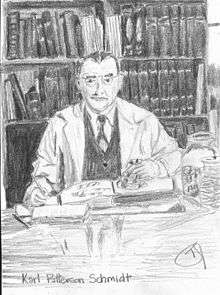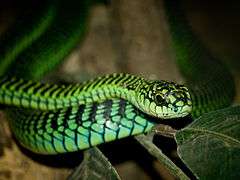Karl Patterson Schmidt
| Karl Patterson Schmidt | |
|---|---|
 | |
| Born |
June 19, 1890 Lake Forest, Illinois, U.S.A. |
| Died |
September 26, 1957 (aged 67) Chicago, Illinois, U.S.A. |
| Citizenship | American |
| Fields | Biology, Herpetology, Animal geographies |
| Institutions | American Museum of Natural History, Chicago Natural History Museum |
| Alma mater | Lake Forest Academy, Cornell University |
| Notable students | Robert F. Inger |
| Notable awards | Guggenheim fellowship (1932), elected to National Academy of Sciences (1956), Ecological Society of America Eminent Ecologist (1957)[1] |
| Author abbrev. (zoology) | K. P. Schmidt |
| Spouse | Margaret Wightman |
Karl Patterson Schmidt (June 19, 1890, Lake Forest, Illinois – September 26, 1957, Chicago) was an American herpetologist.
Family
Schmidt was the son of George W. Schmidt and Margaret Patterson Schmidt. George W. Schmidt was a German professor who, at the time of Karl Schmidt's birth, was teaching in Lake Forest, Illinois. His family left the city in 1907 and settled in Wisconsin. They worked on a farm near Stanley, Wisconsin,[2] where his mother and his younger brother died in a fire on August 7, 1935. The brother, Franklin J. W. Schmidt, had been prominent in the then new field of wildlife management.[3] Karl Schmidt married Margaret Wightman in 1919, and they had two sons, John and Robert.[4]

Education
In 1913, Schmidt entered Cornell University to study biology and geology. In 1915, he discovered his preference for herpetology during a four-month training course at the Perdee Oil Company in Louisiana. In 1916, he received the degree of Bachelor of Arts and made his first geological expedition to Santo Domingo. In 1952 he was awarded an honorary Doctor of Science degree by Earlham College.[4]
Career
From 1916 to 1922, he worked as scientific assistant in herpetology at the American Museum of Natural History in New York, under the well-known American herpetologists Mary Cynthia Dickerson and Gladwyn K. Noble. He made his first collecting expedition to Puerto Rico in 1919, then became the assistant curator of reptiles and amphibians at the Field Museum of Natural History in Chicago in 1922. From 1923 to 1934, he made several collecting expeditions for that museum to Central and South America, which took him to Honduras (1923), Brazil (1926) and Guatemala (1933–1934). In 1937, he became the editor of the herpetology and ichthyology journal Copeia, a post he occupied until 1949. In 1938, he served in the U.S. Army. He became the chief curator of zoology at the Field Museum in 1941, where he remained until his retirement in 1955. From 1942 to 1946, he was the president of the American Society of Ichthyologists and Herpetologists (ASIH). In 1953, he made his last expedition, which was to Israel.
Self-documentation of his death
Schmidt died in 1957 after being bitten by a juvenile boomslang snake (Dispholidus typus). He wrongly believed that it could not produce a fatal dose. Following the bite, he made detailed notes on the symptoms he experienced, almost right up to the end.[5] Schmidt was asked just a few hours before he died if he wanted medical care, but he refused because it would upset the symptoms he was documenting. Boomslang venom works by causing so many small clots in the blood that the victim loses the ability to clot further and bleeds to death. He died 24 hours after the bite, bleeding in his lungs, kidneys, heart, and brain.[6] Marlin Perkins, who was then the director of the Lincoln Park Zoo, had sent the snake to Schmidt's lab at the Field Museum in Chicago for identification.[7][8]
Legacy
Schmidt was one of the most important herpetologists in the 20th century. Though he made only a few important discoveries by himself, he named more than 200 species and was a leading expert on coral snakes.[5] His donation of over 15,000 titles of herpetological literature formed the foundation for The Karl P. Schmidt Memorial Herpetological Library located at the Field Museum.[6]
His writings reveal that he was generally a solid supporter of a W. D. Matthew brand of dispersalism of species.[5]
Taxa
Species and subspecies named for Karl Schmidt
Many species and subspecies of amphibians and reptiles[9][10] are named in his honor, including the following.
- Acanthodactylus schmidti Haas, 1957
- Afrotyphlops schmidti (Laurent, 1956)
- Amphisbaena schmidti Gans, 1964
- Aspidoscelis hyperythra schmidti Van Denburgh & Slevin, 1921
- Batrachuperus karlschmidti Liu, 1950
- Calamaria schmidti Marx & Inger, 1955
- Coniophanes schmidti Bailey, 1937
- Eleutherodactylus karlschmidti C. Grant, 1931
- Emoia schmidti W. Brown, 1954
- Lerista karlschmidti (Marx & Hosmer, 1959)
- Liolaemus schmidti (Marx, 1960)
- Pseudoxenodon karlschmidti Pope, 1928
- Scincella schmidti Barbour, 1927
- Thrasops schmidti Loveridge, 1936
- Tribolonotus schmidti Burt, 1930
- Urosaurus ornatus schmidti (Mittleman, 1940)
- Varanus karlschmidti Mertens, 1951

Some taxa described by Karl Schmidt
- Batrachuperus tibetanus K.P. Schmidt, 1929[11]
- Eleutherodactylus wightmanae K.P. Schmidt, 1920
- Varanus albigularis angolensis K.P. Schmidt, 1933
- Leptopelis parvus K.P. Schmidt & Inger, 1959[12]
- Neurergus kaiseri K.P. Schmidt, 1952
Publications
He wrote more than 200 articles and books, including Living Reptiles of the World, which became an international bestseller.
Books
- 1933 Amphibians and Reptiles Collected by The Smithsonian Biological Survey of the Panama Canal Zone
- 1934 Homes and Habits of Wild Animals
- 1938 Our Friendly Animals and When They Came
- 1941 Field Book of Snakes of the United States and Canada with Delbert Dwight Davis
- 1949 Principles of Animal Ecology with Warder Clyde Allee (1885–1955) and Alfred Edwards Emerson
- 1951 Ecological Animal Geography: An Authorized, Rewritten edition with Warder Clyde Allee, based on Tiergeographie auf oekologischer Grundlage by Richard Hesse. 2nd, John Wiley & Sons, New York
- 1953 A Check List of North American Amphibians and Reptiles
- 1957 Living Reptiles of the World with Robert Frederick Inger
Other publications
- Schmidt, Karl P. 1925. New Reptiles and a salamander from China. American Museum Novitates No. 157[11]
- Schmidt, Karl P. 1930. Reptiles of Marshall Field North Arabian desert expeditions, 1927–1928. Field Museum of Natural History Publication 273, Zoological series vol. 17, no. 6., p. 223-230.[13]
- Schmidt, Karl P. and Shannon, F. A. 1947. Notes on amphibians and reptiles of Michoacan, Mexico. Fieldiana Zool. 31:63–85[14]
References
- ↑ "ESA History/Awards". Ecological Society of America. Archived from the original on May 14, 2008. Retrieved 29 August 2012.
- ↑ Myers, Charles W. (2000). "A History of Herpetology at the American Museum of Natural History" (PDF). Bulletin of the American Museum of Natural History. 252: 5–225 (19–20). doi:10.1206/0003-0090(2000)252<0001:AHOHAT>2.0.CO;2.
- ↑ Leopold, Aldo. "Franklin J. W. Schmidt". Wilson Bulletin. 48 (3): 181–186.
- 1 2 Emerson, Alfred E. (May 1958). "K. P. Schmidt-Herpetologist, Ecologist, Zoogeographer". Science. 3307. 127 (3307): 1162–1163. PMID 17771483. doi:10.1126/science.127.3307.1162.
- 1 2 3 Smith, Charles H. "Chrono-Biographical Sketch: Karl P. Schmidt". Some Biogeographers, Evolutionists and Ecologists. Retrieved 9 September 2014.
- 1 2 "Division of Amphibians and Reptiles History". The Field Museum. Retrieved 7 August 2012.
- ↑ Pope, Clifford H. (1958). "Fatal bite of captive African rear-fanged snake (Dispholidus)". Copeia. 1958 (4): 280. doi:10.2307/1439959.
- ↑ "Diary of A Snakebite Death".
- ↑ Beolens, Bo; Watkins, Michael; Grayson, Michael (2011). The Eponym Dictionary of Reptiles. Baltimore: Johns Hopkins University Press. xiii + 296 pp. ISBN 978-1-4214-0135-5. ("Karl Schmidt", p. 138; "Schmidt, K.P.", p. 236).
- ↑ The Reptile Database. www.reptile-database.org.
- 1 2 Schmidt, Karl P. (February 13, 1925). "New reptiles and a salamander from China" (PDF). American Museum Novitates (157): 1–6. Retrieved 8 August 2012.
- ↑ Schiøtz, Arne (2004). "Leptopelis parvus". IUCN 2012. IUCN Red List of Threatened Species. Version 2012.1. IUCN. Retrieved 30 August 2012.
- ↑ "Field Museum Library". Retrieved 22 August 2012.
- ↑ Schmidt, Karl P.; Shannon, F.A. (Feb 1947). "Notes on amphibians and reptiles of Michoacan, Mexico". Fieldiana: Zoology. 31 (9): 63–85. Retrieved 12 October 2012.
External links
- Works by or about Karl Patterson Schmidt at Internet Archive
- Chrono-Biographical Sketch: Karl P. Schmidt
- Karl Patterson Schmidt Guggenheim Fellows Listing